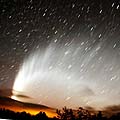
|
Excellent great comet, few times in a lifetime, for southern people. It reached to -5.5 mag on Jan. 14 and 15, brighter than Venus, and visible even in daytime. Then it appeared in the evening sky in the Southern Hemisphere and many people enjoyed a fantastic view of a beautiful great comet, a enormous curving tail with so many striae over 40 degrees. Now it is observable both in the evening and morning. It has already faded down to 2.0 mag (Jan. 26, Alexandre Amorim). It keeps observable almost all night after February until the comet has gone. It will never be observable again in the Northern Hemisphere.
Date(TT) R.A. (2000) Decl. Delta r Elong. m1 Best Time(A, h)
Jan. 27 20 57.52 -48 30.7 1.030 0.527 30 2.1 18:50 ( 48,-28)
Feb. 3 21 16.65 -53 40.4 1.178 0.711 37 4.4 18:56 ( 43,-32)
|
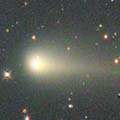
|
It reached up to 9.3 mag between October and November (Oct. 27, Juan Jose Gonzalez). It had been observable in excellent condition. But it is fading now. It has already faded down to 11.8 mag (Jan. 20, Carlos Labordena). However, it keeps observable after this until May when it fades down to 16 mag. It will keep visible visually until around March.
Date(TT) R.A. (2000) Decl. Delta r Elong. m1 Best Time(A, h)
Jan. 27 3 27.29 7 3.9 1.300 1.815 104 11.7 19:03 ( 0, 62)
Feb. 3 3 39.76 8 6.0 1.385 1.843 100 12.0 18:56 ( 4, 63)
|
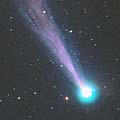
|
It suddenly brightened in outburst on Oct. 24, and reached up to 4.2 mag on Oct. 25 (Maik Meyer). But it had faded down to 10.5 mag on Jan. 11 (Carlos Labordena). Now it is not observable. It will appear in the morning sky again at 15-16 mag in May. Then it keeps observable until it becomes fainter than 18 mag in autumn.
Date(TT) R.A. (2000) Decl. Delta r Elong. m1 Best Time(A, h)
Jan. 27 21 38.09 -6 17.9 3.069 2.166 19 12.5 18:50 ( 81, 1)
Feb. 3 21 46.86 -6 45.0 3.200 2.258 14 12.9 18:56 ( 85, -4)
|
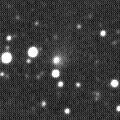
|
Now it is 12.2 mag (Dec. 28, Juan Jose Gonzalez). It keeps 12-13 mag until March and visible visually.
Date(TT) R.A. (2000) Decl. Delta r Elong. m1 Best Time(A, h)
Jan. 27 18 6.04 42 58.3 2.274 2.156 70 12.6 5:35 (241, 42)
Feb. 3 18 27.41 47 17.5 2.263 2.189 73 12.7 5:31 (235, 44)
|
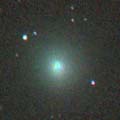
|
When it approached to the earth between from November to early December, it reached up to 8.5 mag as a very large diffuse object with a diameter larger than 10 arcmin (Nov. 23, Peter Bus). However, now it is fading rapidly. It has already faded down to 12.2 mag (Jan. 20, Carlos Labordena). It will be fainter than 14 mag, too faint to see visually, in February. It will set down in the evening sky at 17 mag in March.
Date(TT) R.A. (2000) Decl. Delta r Elong. m1 Best Time(A, h)
Jan. 27 1 23.51 37 32.3 1.798 2.017 87 13.3 18:50 (105, 67)
Feb. 3 1 19.37 36 19.1 2.009 2.080 80 13.9 18:56 (104, 60)
|

|
In this season, it has been bright as 12-13 mag and visible visually since it appeared in the morning sky in early July. Now it is 13.1 mag (Dec. 22, Seiichi Yoshida). Diffuse, and not easy to see visually. However, it looks very large on CCD images, with a diameter of about 2 arcmin. It keeps observable in good condition until March.
Date(TT) R.A. (2000) Decl. Delta r Elong. m1 Best Time(A, h)
Jan. 27 3 43.32 29 6.9 5.418 5.878 113 13.4 19:18 ( 0, 84)
Feb. 3 3 43.86 28 55.4 5.525 5.880 106 13.5 18:56 ( 10, 84)
|
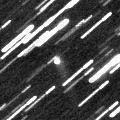
|
Now it is 14.1 mag (Jan. 15, Maciej Reszelski). Almost asteroidal. It did not brighten at all since early September. Although the slight cometary activity was detected in late July, it became completely stellar soon. Its tail became visible again in late October, however, it turned to be stellar again soon. Finally it has passed the perihelion, keeping almost asteroidal. In the Northern Hemisphere, it keeps good condition after this. It keeps locating high until spring. It is fainter than this ephemeris recently.
Date(TT) R.A. (2000) Decl. Delta r Elong. m1 Best Time(A, h)
Jan. 27 1 34.35 47 0.1 0.752 1.276 93 13.7 18:50 (131, 68)
Feb. 3 2 27.23 45 17.2 0.768 1.306 95 13.7 18:56 (130, 72)
|
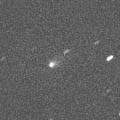
|
It had been unobservble for a long time. When it appeared again in the morning sky, it has showed a cometary activity and it has become much brighter than expected. It was visible visually on Oct. 31 at 13.7 mag (Seiichi Yoshida). It is bright as 13.8 mag still now (Dec. 29, Katsumi Yoshimoto). It keeps 13-14 mag until March. It is observable in good condition in the Southern Hemisphere, although it is already not observable in the Northern Hemisphere.
Date(TT) R.A. (2000) Decl. Delta r Elong. m1 Best Time(A, h)
Jan. 27 14 16.38 -56 30.9 2.067 2.083 77 13.7 5:35 (357, -2)
Feb. 3 14 34.59 -59 11.1 2.054 2.109 79 13.8 5:31 (358, -4)
|
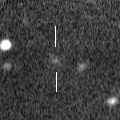
|
First return of a new bright periodic comet observed at 9 mag in 2001. Filip Fratev caught it on Jan. 11 at 16.1 mag. It is fainter than expected by 2.5 mag. The condition of this apparition is bad. It keeps locating very low in the evening. Although it was expected to reach up to 11 mag in February and March, it will be 14 mag at best in fact.
Date(TT) R.A. (2000) Decl. Delta r Elong. m1 Best Time(A, h)
Jan. 27 22 13.59 -6 0.7 1.803 1.027 26 14.6 18:50 ( 76, 9)
Feb. 3 22 42.37 -4 19.0 1.761 0.990 27 14.1 18:56 ( 79, 9)
|
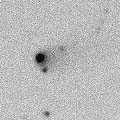
|
It has been visible at 13.5 mag for a long time since 2005 autumn until 2006 spring. Now it is fainter than last year by 1 mag, however, it is still visible visually at 14.2 mag (Dec. 22, Seiichi Yoshida). It keeps observable in excellent condition until April.
Date(TT) R.A. (2000) Decl. Delta r Elong. m1 Best Time(A, h)
Jan. 27 13 13.77 22 33.2 5.139 5.632 115 14.4 4:51 ( 0, 78)
Feb. 3 13 13.94 22 46.9 5.076 5.652 121 14.4 4:23 ( 0, 78)
|

|
It is observable in good condition in the Southern Hemisphere. But it is not observable until January in the Northern Hemisphere. It was discovered at 17.5 mag in May. Then it has not been brightening well. It is 16.5-17 mag still in December. It will be observable also in the Northern Hemisphere in the evening low sky from January to March, however, it will be fainter than 15 mag.
Date(TT) R.A. (2000) Decl. Delta r Elong. m1 Best Time(A, h)
Jan. 27 2 31.22 -35 56.8 2.560 2.549 78 15.1 18:50 ( 9, 19)
Feb. 3 2 29.14 -31 37.7 2.625 2.536 73 15.1 18:56 ( 18, 21)
|

|
Now it is 15.5 mag (Dec. 3, Ken-ichi Kadota). It is observable at 15.5-16 mag until spring. But, in the Northern Hemisphere, it locates somewhat low at 20-30 degree high.
Date(TT) R.A. (2000) Decl. Delta r Elong. m1 Best Time(A, h)
Jan. 27 5 41.38 -33 33.4 3.405 3.901 113 15.6 21:15 ( 0, 22)
Feb. 3 5 27.84 -32 34.5 3.469 3.896 108 15.6 20:34 ( 0, 23)
|
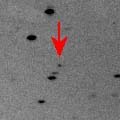
|
It will reach to 6 mag at the perihelion passage in mid April. It is observale while brightening gradually in the evening sky in the Northern Hemisphere. However, it will locate very low when it becomes bright enough to see visually. It will be 14 mag in mid February, when the altitude becomes lower than 20 degree. It will be 11.5 mag in mid March, when the altitude becomes lower than 10 degree. After conjunction with the sun, it appears in the morning sky at 12 mag in June. But it locates only 20 degree high at most, and it will be fading rapidly. In the Southern Hemisphere, it appears in the morning sky at 8 mag in May, then it will be bright and observable for a while.
Date(TT) R.A. (2000) Decl. Delta r Elong. m1 Best Time(A, h)
Jan. 27 23 35.01 5 3.2 2.023 1.583 50 16.3 18:50 ( 73, 31)
Feb. 3 23 44.86 5 58.7 2.002 1.491 45 15.6 18:56 ( 78, 27)
|

|
Now it is 15.9 mag (Jan. 10, Ken-ichi Kadota). It keeps observable at 15 mag in the evening sky until May. It is not observable around the perihelion passage in conjunction with the sun. Then it moves to the southern sky, and it will be unobservable in the Northern Hemisphere.
Date(TT) R.A. (2000) Decl. Delta r Elong. m1 Best Time(A, h)
Jan. 27 2 36.69 50 17.9 2.385 2.797 104 15.9 18:50 (159, 73)
Feb. 3 2 43.68 49 6.6 2.399 2.736 99 15.8 18:56 (145, 72)
|
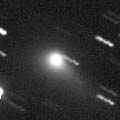
|
It was still visible visually at 14.2 mag on Oct. 31 (Seiichi Yoshida). However, it has already faded down to 15.8 mag (Dec. 15, Ernesto Guido and Giovanni Sostero). It keeps a good contition until spring, while the comet will be fading gradually.
Date(TT) R.A. (2000) Decl. Delta r Elong. m1 Best Time(A, h)
Jan. 27 9 42.16 26 11.0 3.370 4.321 162 16.3 1:20 ( 0, 81)
Feb. 3 9 36.45 26 25.6 3.418 4.386 167 16.4 0:47 ( 0, 81)
|
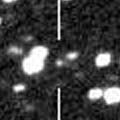
|
It tends to become brightest about 4 months after the perihelion passage. In this apparition, it was 17.6 mag in late July around the perihelion passage (July 23, Filip Fratev), however, it brightened up to 14.1 mag and became visible visually on Dec. 23 (Seiichi Yoshida). But it will start fading after this. Although it keeps a good condition for a long time, it will be fainter than 18 mag in March.
Date(TT) R.A. (2000) Decl. Delta r Elong. m1 Best Time(A, h)
Jan. 27 5 21.46 20 26.4 1.560 2.356 134 16.4 20:56 ( 0, 75)
Feb. 3 5 22.73 20 56.7 1.657 2.390 127 16.7 20:30 ( 0, 76)
|

|
It will be brightening gradually at the high altitude until 2007 spring, while it brightens up to 16 mag. Then it keeps 15.5-16 mag for one year and a half until 2008 summer. However, because the comet moves southwards, it is only observable until 2007 June in the Northern Hemisphere.
Date(TT) R.A. (2000) Decl. Delta r Elong. m1 Best Time(A, h)
Jan. 27 11 7.78 4 14.0 3.242 4.048 140 16.8 2:45 ( 0, 59)
Feb. 3 11 4.55 3 50.2 3.130 3.999 147 16.7 2:14 ( 0, 59)
|
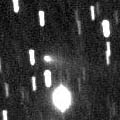
|
It was expected to reach to 13 mag in winter. But actually, it was 15.7 mag at best (Dec. 5, Ken-ichi Kadota), much fainter than expected. It will fade out rapidly after this. It will be fainter than 18 mag in February.
Date(TT) R.A. (2000) Decl. Delta r Elong. m1 Best Time(A, h)
Jan. 27 7 58.03 60 38.5 0.880 1.738 137 16.7 23:32 (180, 64)
Feb. 3 7 52.85 61 54.7 0.938 1.765 133 17.0 22:59 (180, 63)
|

|
Now it is 16.8 mag (Dec. 29, Katsumi Yoshimoto). It is outside of Jupiter's orbit. So it keeps 17 mag for a long time until 2007 summer. It keeps locating high and observable in good condition for a long time after this because it moves in the northern sky.
Date(TT) R.A. (2000) Decl. Delta r Elong. m1 Best Time(A, h)
Jan. 27 14 50.31 38 14.5 6.956 7.171 98 17.1 5:35 (249, 79)
Feb. 3 14 50.40 38 32.8 6.899 7.185 103 17.1 5:31 (236, 83)
|
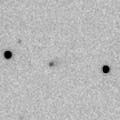
|
It reached to 16 mag in early 2006. Now it is 17.3 mag (Dec. 2, Ken-ichi Kadota). It will be fading very slowly from 17 mag to 18 mag until 2007 summer. In the Northern Hemisphere, it keeps locating high.
Date(TT) R.A. (2000) Decl. Delta r Elong. m1 Best Time(A, h)
Jan. 27 14 22.15 31 34.6 5.352 5.646 102 17.2 5:35 (303, 84)
Feb. 3 14 23.52 31 55.4 5.300 5.671 107 17.2 5:31 (353, 87)
|
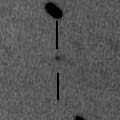
|
Now it is 16.8 mag (Jan. 9, Mitsunori Tsumura). The perihelion passage is in 2008. It will be observable for several years after this at around 17 mag. But it may fade out rapidly just after the perihelion passage.
Date(TT) R.A. (2000) Decl. Delta r Elong. m1 Best Time(A, h)
Jan. 27 4 11.91 12 34.2 4.131 4.654 116 17.3 19:46 ( 0, 68)
Feb. 3 4 11.92 12 58.9 4.219 4.643 109 17.3 19:19 ( 0, 68)
|

|
Recovered at 19.3 mag on Nov. 18 (E. J. Christensen). It is a tiny comet, however, it will pass near, only 0.3 A.U., by the earth in February and will be 17 mag. It moves northern sky and it is observable in good condition in the Northern Hemisphere. However, it will be fade out soon, will be fainter than 18 mag in March.
Date(TT) R.A. (2000) Decl. Delta r Elong. m1 Best Time(A, h)
Jan. 27 0 32.63 43 1.3 0.305 0.990 82 17.4 18:50 (118, 58)
Feb. 3 0 18.46 51 39.2 0.300 0.981 80 17.3 18:56 (132, 49)
|
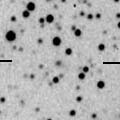
|
It keeps 17 mag until January. Then it keeps observable util April when it becomes fainter than 18 mag.
Date(TT) R.A. (2000) Decl. Delta r Elong. m1 Best Time(A, h)
Jan. 27 3 58.73 49 19.4 3.264 3.820 117 17.4 19:34 (180, 76)
Feb. 3 4 0.95 48 45.3 3.343 3.819 111 17.4 19:08 (180, 76)
|
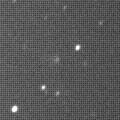
|
It reached up to 16 mag in 2005 summer in the Southern Hemisphere. Now it is 17.2 mag (Dec. 4, Ken-ichi Kadota). The brightening was very slow, and the fading seems also very slow. It will keep 17 mag until January after this. But then it will turn to fade out rapidly, and will be fainter than 18 mag in February.
Date(TT) R.A. (2000) Decl. Delta r Elong. m1 Best Time(A, h)
Jan. 27 4 50.51 -14 29.4 4.815 5.312 115 17.4 20:25 ( 0, 41)
Feb. 3 4 49.02 -13 12.5 4.932 5.352 110 17.5 19:56 ( 0, 42)
|
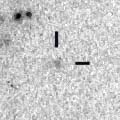
|
It was observed at 17.5 mag in 2006 spring. It will be observable at 17 mag in good condition in 2007 spring.
Date(TT) R.A. (2000) Decl. Delta r Elong. m1 Best Time(A, h)
Jan. 27 14 9.50 -12 34.5 4.579 4.718 92 17.5 5:35 (356, 42)
Feb. 3 14 11.85 -12 49.8 4.470 4.719 98 17.4 5:21 ( 0, 42)
|

|
It is observable in excellent condition at 17.5 mag in December and January. It will be fainer than 18 mag in March.
Date(TT) R.A. (2000) Decl. Delta r Elong. m1 Best Time(A, h)
Jan. 27 6 10.43 28 50.0 1.448 2.327 145 17.5 21:45 ( 0, 84)
Feb. 3 6 8.97 28 36.7 1.500 2.328 138 17.6 21:16 ( 0, 84)
|

|
It had been lost since its discovery in 1986. But it was rediscovered on Jan. 9 at 16-17 mag. The condition is good in this return, and it was expected to reach to 14 mag from autumn to winter. But actually, it is fainter than originally expected, and it seems to have reached to 17 mag at best. It will be fainter than 18 mag in February.
Date(TT) R.A. (2000) Decl. Delta r Elong. m1 Best Time(A, h)
Jan. 27 23 49.71 0 7.9 1.891 1.486 51 17.6 18:50 ( 65, 31)
Feb. 3 0 11.14 2 23.9 1.949 1.514 49 17.8 18:56 ( 70, 30)
|
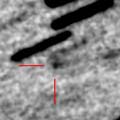
|
It was observed at 19 mag in mid December. It will reach to 17 mag in spring, and will be observable in good condition.
Date(TT) R.A. (2000) Decl. Delta r Elong. m1 Best Time(A, h)
Jan. 27 11 14.41 2 49.7 1.622 2.446 138 17.9 2:52 ( 0, 58)
Feb. 3 11 13.48 2 58.8 1.547 2.425 145 17.7 2:23 ( 0, 58)
|

|
It was visible visually at 12 mag in last spring. Now it is 17.2 mag (Dec. 29, Katsumi Yoshimoto), brighter than this ephemeris. It will keep good condition for a while after this, but it will be fading gradually.
Date(TT) R.A. (2000) Decl. Delta r Elong. m1 Best Time(A, h)
Jan. 27 16 49.91 37 0.3 4.562 4.445 76 17.7 5:35 (254, 55)
Feb. 3 16 52.36 38 41.9 4.560 4.509 80 17.8 5:31 (252, 60)
|
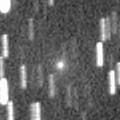
|
Although it was so faint as 20.7 mag on Aug. 2 (P. Birtwhistle), it brightened rapidly as expected, and reached up to 15.7 mag on Nov. 15 (Ken-ichi Kadota). After it passed the perihelion, it has not started fading yet. It is bright as 16.1 mag still now (Dec. 19, Ken-ichi Kadota). In the Northern Hemisphere, it keeps a good condition for a long time after this. It will be observable at 16-17 mag for a while.
Date(TT) R.A. (2000) Decl. Delta r Elong. m1 Best Time(A, h)
Jan. 27 5 2.08 66 14.9 1.016 1.744 121 17.8 20:38 (180, 59)
Feb. 3 5 16.20 64 45.6 1.085 1.783 118 18.1 20:24 (180, 60)
|

|
Peculiar asteroid moving along an orbit like a comet. It reaches up to 17.5 mag in mid January. But it will be fainter than 18 mag in February. It is observable in an excellent condition in the Northern Hemisphere.
Date(TT) R.A. (2000) Decl. Delta r Elong. m1 Best Time(A, h)
Jan. 27 7 19.77 23 36.8 1.677 2.630 161 17.8 22:54 ( 0, 79)
Feb. 3 7 16.09 23 58.7 1.700 2.620 153 18.0 22:22 ( 0, 79)
|

|
Now it is around the aphelion and faintest, but it is observed at 18 mag. It will be observable at 18 mag in good condition until March. It will be 13-14 mag and visible visually again in 2009. It will reach to 12.5 mag in 2010. But in the Northern Hemisphere, it will locate very low in the south at that time.
Date(TT) R.A. (2000) Decl. Delta r Elong. m1 Best Time(A, h)
Jan. 27 5 39.30 28 40.1 3.927 4.710 138 17.8 21:13 ( 0, 84)
Feb. 3 5 36.48 28 38.9 4.002 4.707 130 17.9 20:43 ( 0, 84)
|

|
It was in major outburst unexpectedly and reached to 10.5 mag in its last appearance in 1999. However, it is faint in this apparition. Now it is 17.4 mag (Nov. 23, Ken-ichi Kadota). It will fade out gradually after this.
Date(TT) R.A. (2000) Decl. Delta r Elong. m1 Best Time(A, h)
Jan. 27 13 52.73 -17 52.3 2.022 2.310 94 18.3 5:30 ( 0, 37)
Feb. 3 13 57.13 -18 56.2 1.971 2.348 99 18.4 5:06 ( 0, 36)
|
|
![]()
 C/2005 EL173 ( LONEOS )
C/2005 EL173 ( LONEOS ) 2P/Encke
2P/Encke C/2006 XA1 ( LINEAR )
C/2006 XA1 ( LINEAR ) C/2005 E2 ( McNaught )
C/2005 E2 ( McNaught ) 84P/Giclas
84P/Giclas C/2006 V1 ( Catalina )
C/2006 V1 ( Catalina ) 76P/West-Kohoutek-Ikemura
76P/West-Kohoutek-Ikemura C/2002 VQ94 ( LINEAR )
C/2002 VQ94 ( LINEAR ) C/2004 D1 ( NEAT )
C/2004 D1 ( NEAT ) 173P/2005 T1 ( Mueller 5 )
173P/2005 T1 ( Mueller 5 ) 182P/2006 W2 ( LONEOS )
182P/2006 W2 ( LONEOS ) P/2005 SB216 ( LONEOS )
P/2005 SB216 ( LONEOS ) C/2004 L2 ( LINEAR )
C/2004 L2 ( LINEAR ) 99P/Kowal 1
99P/Kowal 1 P/2006 U5 ( Christensen )
P/2006 U5 ( Christensen ) 184P/2007 A1 ( Lovas 2 )
184P/2007 A1 ( Lovas 2 ) 87P/Bus
87P/Bus C/2004 B1 ( LINEAR )
C/2004 B1 ( LINEAR ) 112P/Urata-Niijima
112P/Urata-Niijima 2006 SV301
2006 SV301 65P/Gunn
65P/Gunn 52P/Harrington-Abell
52P/Harrington-Abell![]()






















